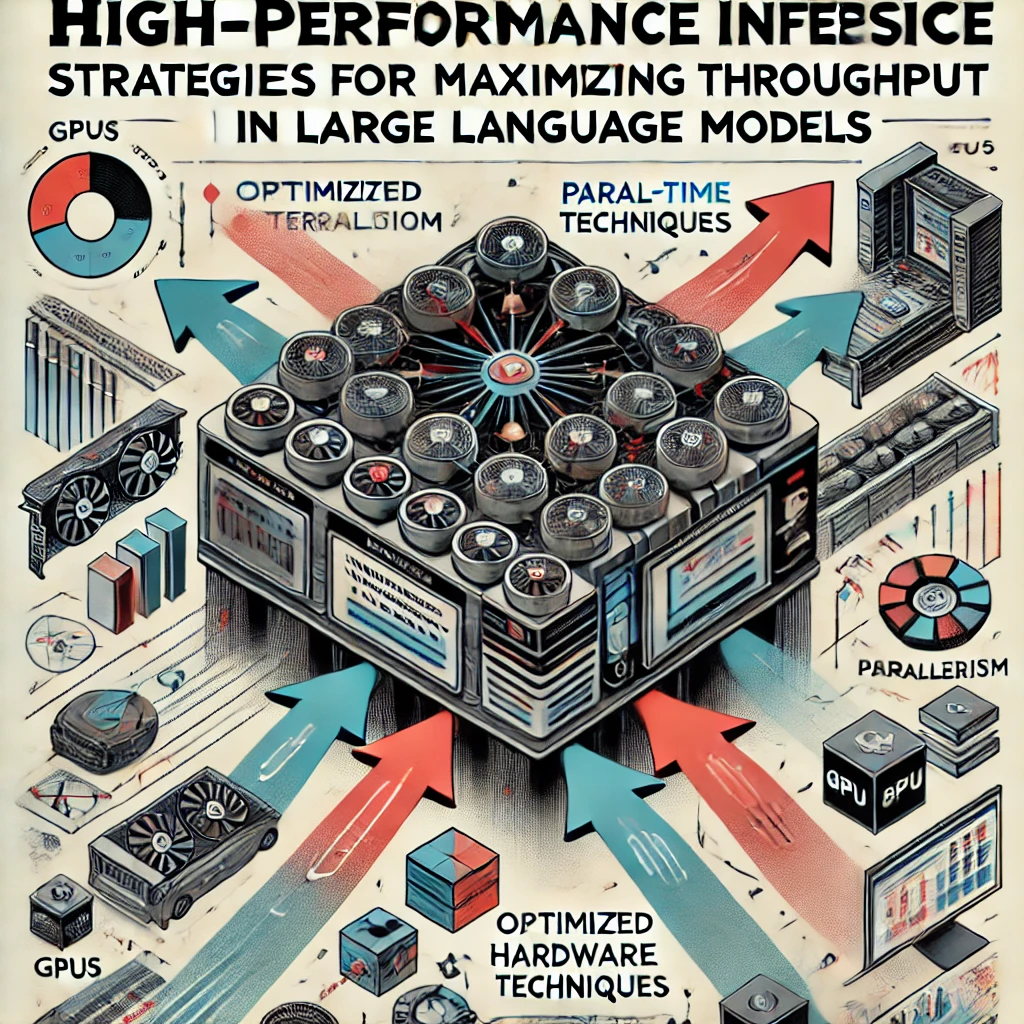In the realm of artificial intelligence, large language models (LLMs) have become essential tools for a variety of applications, from natural language processing to complex data analysis. However, the efficiency and effectiveness of these models are heavily dependent on their ability to perform real-time inference at scale. Maximizing throughput—the rate at which a model processes data—is critical for applications that require fast and accurate results. This article explores strategies for achieving high-performance inference in LLMs, focusing on hardware optimization, parallelism techniques, and the importance of benchmarking and monitoring.
Optimizing Hardware Utilization

Optimizing the use of hardware is one of the most effective ways to increase inference speed in large language models. Both GPUs (Graphics Processing Units) and CPUs (Central Processing Units) play crucial roles in processing tasks, but their capabilities must be fully leveraged to achieve maximum throughput.
- GPU Optimization:
- GPUs are particularly well-suited for the parallel processing required by LLMs. They can handle multiple operations simultaneously, making them ideal for tasks like matrix multiplications and other computations that are core to the functioning of LLMs.
- To optimize GPU performance, it is essential to ensure that the GPU is not bottlenecked by other components, such as the CPU or memory bandwidth. Configuring the GPU with the appropriate drivers and ensuring that it is fully utilized during inference tasks can significantly enhance performance.
- CPU Optimization:
- While GPUs handle most of the heavy lifting, CPUs are responsible for managing the data flow and executing non-parallel tasks. Optimizing CPU performance involves ensuring that the CPU is not overloaded with too many tasks that could be offloaded to the GPU.
- Techniques such as thread management and cache optimization can help improve CPU performance. Additionally, using multi-core CPUs effectively can distribute the workload evenly, reducing processing time and increasing throughput.
By optimizing both GPUs and CPUs, you can ensure that the hardware is working at its full potential, providing the computational power necessary for high-performance inference in LLMs.
Parallelism Techniques

Parallelism is another key strategy for maximizing throughput in large language models. By dividing tasks into smaller, independent units that can be processed simultaneously, parallelism can significantly speed up inference.
- Parallel Sampling:
- Parallel sampling is a technique where multiple samples are generated at once, rather than sequentially. This approach is particularly useful in scenarios where the model needs to generate multiple outputs quickly, such as in real-time translation or conversational AI.
- Implementing parallel sampling requires careful management of resources to ensure that each parallel process is allocated the appropriate amount of memory and computational power. When done correctly, it can lead to substantial improvements in throughput.
- Beam Search:
- Beam search is another parallelism technique commonly used in LLMs. It involves exploring multiple possible outcomes simultaneously to find the most likely result. By evaluating several paths at once, beam search can improve the accuracy of model predictions without sacrificing speed.
- To implement beam search effectively, it is important to balance the beam width (the number of paths explored) with the available computational resources. A wider beam can lead to more accurate results, but it also requires more processing power.
Both parallel sampling and beam search are powerful tools for increasing the speed and efficiency of LLM inference, making them essential techniques for achieving high-performance AI models.
Benchmarking and Monitoring

To ensure that your optimization strategies are effective, benchmarking and monitoring are essential practices. By tracking performance metrics, you can identify bottlenecks and areas for improvement, allowing you to fine-tune your model for maximum throughput.
- Benchmarking Tools:
- Several tools are available for benchmarking AI models, including industry-standard software that measures inference speed, memory usage, and overall efficiency. Tools like TensorFlow Profiler, NVIDIA Nsight, and PyTorch Profiler provide detailed insights into how your model is performing and where optimizations can be made.
- Regular benchmarking allows you to compare different versions of your model and hardware configurations, ensuring that each change leads to measurable improvements in performance.
- Performance Monitoring:
- Monitoring the performance of your model in real time is also crucial. Performance monitoring tools can track metrics such as latency, throughput, and error rates during inference, alerting you to potential issues before they impact the user experience.
- By integrating performance monitoring into your deployment pipeline, you can maintain high throughput and reliability, even as the demands on your model increase.
Benchmarking and monitoring are not one-time tasks but ongoing processes that help maintain and improve the performance of your LLMs over time.
Conclusion
Maximizing throughput is essential for achieving high-performance inference in large language models. By optimizing hardware utilization, implementing parallelism techniques like parallel sampling and beam search, and continuously benchmarking and monitoring your model’s performance, you can ensure that your LLMs deliver fast and accurate results in real-time applications.
As AI technology continues to advance, the demand for high-performance inference will only grow. Integrating these strategies into your workflow not only enhances the current performance of your models but also prepares them to meet future challenges. With tools like vLLM, which provide optimized environments for large language models, developers can further streamline their workflows, ensuring that their models operate at peak efficiency. Whether for real-time applications, data analysis, or content generation, focusing on maximizing throughput is key to unlocking the full potential of large language models.
